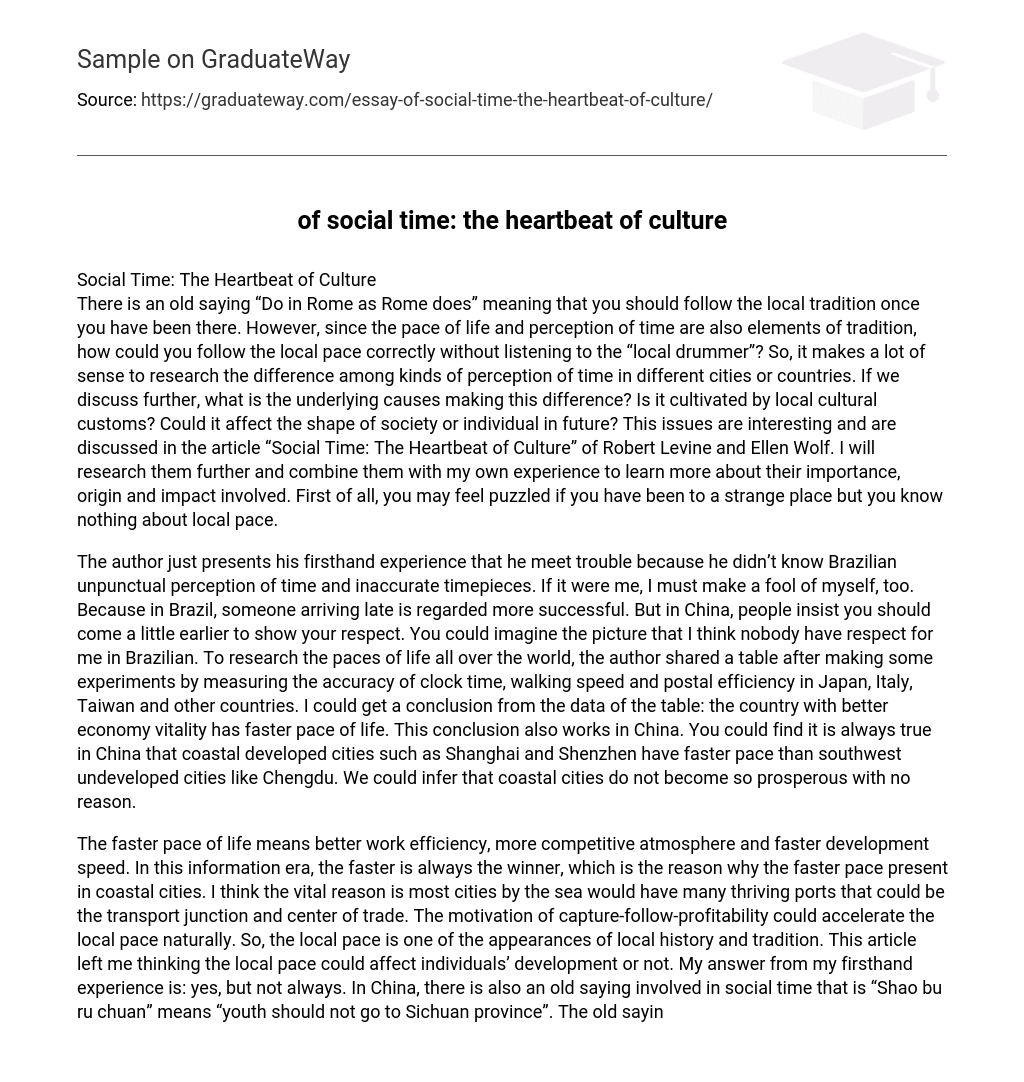Social Time: The Heartbeat of Culture
There is an old saying “Do in Rome as Rome does” meaning that you should follow the local tradition once you have been there. However, since the pace of life and perception of time are also elements of tradition, how could you follow the local pace correctly without listening to the “local drummer”? So, it makes a lot of sense to research the difference among kinds of perception of time in different cities or countries. If we discuss further, what is the underlying causes making this difference? Is it cultivated by local cultural customs? Could it affect the shape of society or individual in future? This issues are interesting and are discussed in the article “Social Time: The Heartbeat of Culture” of Robert Levine and Ellen Wolf. I will research them further and combine them with my own experience to learn more about their importance, origin and impact involved. First of all, you may feel puzzled if you have been to a strange place but you know nothing about local pace.
The author just presents his firsthand experience that he meet trouble because he didn’t know Brazilian unpunctual perception of time and inaccurate timepieces. If it were me, I must make a fool of myself, too. Because in Brazil, someone arriving late is regarded more successful. But in China, people insist you should come a little earlier to show your respect. You could imagine the picture that I think nobody have respect for me in Brazilian. To research the paces of life all over the world, the author shared a table after making some experiments by measuring the accuracy of clock time, walking speed and postal efficiency in Japan, Italy, Taiwan and other countries. I could get a conclusion from the data of the table: the country with better economy vitality has faster pace of life. This conclusion also works in China. You could find it is always true in China that coastal developed cities such as Shanghai and Shenzhen have faster pace than southwest undeveloped cities like Chengdu. We could infer that coastal cities do not become so prosperous with no reason.
The faster pace of life means better work efficiency, more competitive atmosphere and faster development speed. In this information era, the faster is always the winner, which is the reason why the faster pace present in coastal cities. I think the vital reason is most cities by the sea would have many thriving ports that could be the transport junction and center of trade. The motivation of capture-follow-profitability could accelerate the local pace naturally. So, the local pace is one of the appearances of local history and tradition. This article left me thinking the local pace could affect individuals’ development or not. My answer from my firsthand experience is: yes, but not always. In China, there is also an old saying involved in social time that is “Shao bu ru chuan” means “youth should not go to Sichuan province”. The old saying reveals the fact that the pace of life in Sichuan is so lazy and local people live so comfortable that is regarded be harmful for struggle of youth. Chinese always insist that only hard environment could create excellent talent.
However, I do not think I was influenced by it since I have studied there for two years and I think the power of personality is more important than environment. It is reasonable to think it would require more effort to defend the lazy atmosphere but if you could devote yourself to your career, slow pace of life could provide you with a low-stress and high-happiness environment that benefits your fight in long term. Pace of social time vary from place to place and it is meaningful to learn about it. It reflects the various traditions and different cultures that cultivated kinds of them. It comes from the forge of local history and it affects the shape of social future. We need understand the true significance of the difference of paces because in this constantly changing era, who sets the pace, who is the leader. Each of the fast pace and low pace has its own merits that we should listen local pace carefully and adjust ourselves to adapt it.
Reference Robert Levine, Ellen Wolf. (2007). Social Time: the Heartbeat of Culture. In R. Spack, Guidelines: A Cross-Cultural Reading/Writing Text (pp. 75-81). New York: Cambridge University Press.





